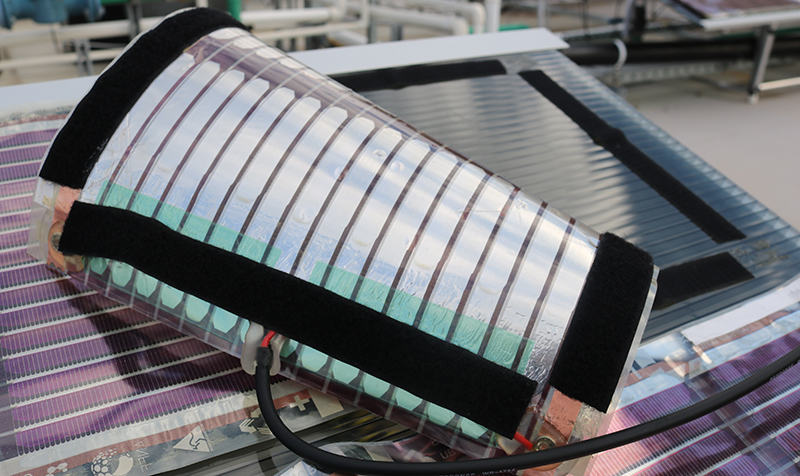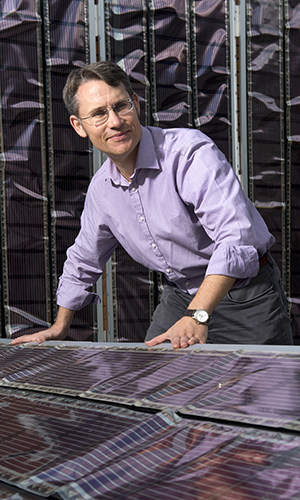The clever electronic inks rewriting our energy future
Australia’s position as a global leader in printed solar has surged, following the unveiling of its first printed solar demonstration site at the University of Newcastle (UON) today.
Printed solar creator, UON’s Professor Paul Dastoor said that at one hundred square metres in size, there were only two other comparable sites worldwide.
“There are just three demonstration sites at this scale that we know of anywhere in the world, so Australia has joined quite an elite group of global leaders poised to make this technology a commercial reality,” said Professor Dastoor.
Professor Dastoor said the material could be rapidly manufactured, enabling accelerated deployment into the marketplace.
“No other renewable energy solution can be manufactured as quickly. On our lab-scale printer we can easily produce hundreds of metres of material per day, on a commercial-scale printer this would increase to kilometres. If you had just ten of these printers operating around the clock we could print enough material to deliver power to 1000 homes per day,” said Professor Dastoor.
“The low-cost and speed at which this technology can be deployed is exciting, particularly in the current Australian energy context where we need to find solutions, and quickly, to reduce demand on base-load power.”
Professor Dastoor said the demonstration site enabled final phase testing and modifications of the system before the renewable energy technology could be made available to the public.
“This installation brings us closer than we have ever been to making this technology a reality. It will help to determine the lifespan of the material and provide half-hourly feedback on the performance of the system,” said Professor Dastoor.
How it is made

The material is made by printing an advanced electronic ink onto paper thin, clear laminated sheets using conventional printing presses. Importantly, Professor Dastoor’s UON team pioneered both the electronic ink and printing process.
“On the back of five years of in-house development, all of the components of these advanced electronic inks are now synthesised at scale within our Centre for Organic Electronics using non-toxic carbon-based materials. These components are then used directly or further processed into water-based inks and paints,” said Professor Dastoor.
New manufacturing revenue stream
While Professor Dastoor’s electronic ink is rewriting our energy future, it may also create beneficial new markets in the printing industry.
The material will deliver a new, ‘functional printing’ revenue stream for the printing industry – the second largest manufacturing industry in Australia.
Unprecedented affordability
The technology delivers unprecedented affordability at a production cost of less than $10 a square metre.
Professor Dastoor said a new service delivery model could round out the innovation process, removing key barriers to solar uptake in the community.
“It might operate like a telephone line, where customers choose a service plan based on their usage requirements but do not need to outlay the physical cost of the line installation and associated upkeep. The system is owned, maintained and updated by the provider and customers could scale their plan up or down as their requirements change,” said Professor Dastoor.
“By reinventing the delivery model we remove the need for initial lump sum outlays, overcoming the key barrier to community uptake and ensuring that the science actually ends up on our rooftops,” said Professor Dastoor.
Performance
 Initially, the electrical output of the site is being used for scientific study - for the first time allowing Australian researchers to monitor how large areas of these unique printed solar cells respond under different real-world conditions.
Initially, the electrical output of the site is being used for scientific study - for the first time allowing Australian researchers to monitor how large areas of these unique printed solar cells respond under different real-world conditions.
Professor Dastoor said that unlike traditional PV panels, the technology maintained a more constant power flow in low-light and cloud cover.
“Our printed solar solution continues to function consistently in low light and under cloud cover, which means that users don’t experience dips in productivity.”
So sensitive, the material can even produce small quantities of energy from moonlight.
Applications
So light, the film is tethered to the roof and walls of the demonstration site by mere Velcro strips, and ‘roll-out’ is exactly that…’rolling out’ a long sheet of the laminated material.
Professor Dastoor said the light-weight, easy installation qualities of the material, printed at UON's NIER facility, could help cast a new light on age-old energy problems.
“The technology is low-cost and very portable making it ideal for applications in Majority World countries where an estimated 1.2 billion people still have no access to electricity.”
“Because it is light and can be printed quickly it is also ideal for disaster relief and recovery applications supporting displaced people and powering temporary emergency bases. The material can be safely airdropped and very easily installed.”
“It could be ideal for forward operating bases and special operations as it lightweight – the lightest energy generation technology by kilo that exists, and produces no noise.”
“The material could also be used as sails for yachts and on ship decks.”
Industry interest
The technology has already attracted its first commercial partner, global logistics solutions company CHEP.
CHEP Australia’s Senior Manager, Sustainability Asia-Pacific Lachlan Feggans said they were working with UON to rollout a commercial scale pilot installation of organic printed solar on the roof of one of its service centres next financial year.
“Through our collaboration with UON, we see the potential to make CHEP’s inherently sustainable business model even better. Our aim is to develop better supply chains, but we recognise that this begins with sustainability in our own operations,” said Mr Feggans.
Professor Dastoor has been invited to demonstrate his technology at major printing tradeshow Pacprint at the Melbourne Convention and Exhibition Centre from 23-26 May, which will include Australia’s first public display of his futuristic energy technology.
“We’ll be installing a custom built pop-up site which will also be approximately 100 square metres in size. This will be the first ever public display of the technology and people will be able to touch the material and walk through and under it,” said Professor Dastoor.
Related news
- Advancing Human-Agent Collaboration Through Agentic AI
- From Research to Reality: New Algorithms Revolutionise Geotechnical Design
- Scientists find a fast, new way to recover high-grade silver from end-of-life solar panels
- University of Newcastle’s I2N takes out top honours
- HMRI celebrates excellence in research and innovation at 2025 awards
The University of Newcastle acknowledges the traditional custodians of the lands within our footprint areas: Awabakal, Darkinjung, Biripai, Worimi, Wonnarua, and Eora Nations. We also pay respect to the wisdom of our Elders past and present.